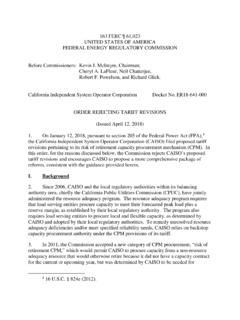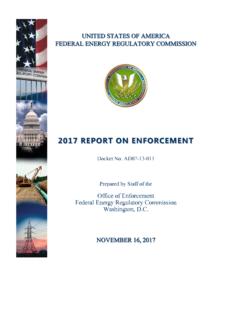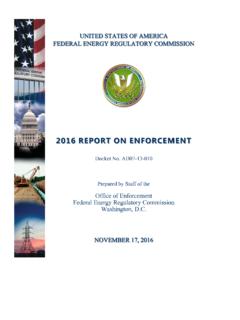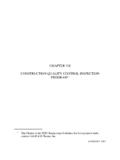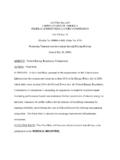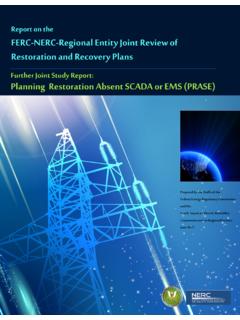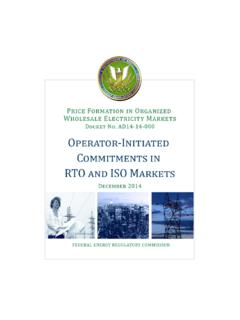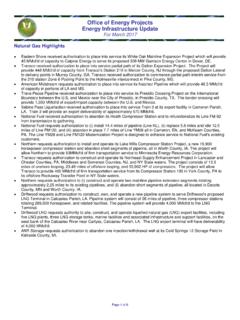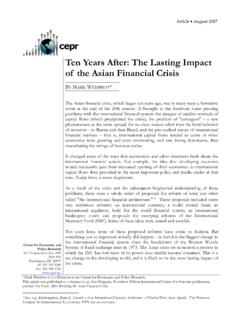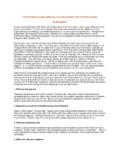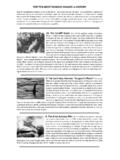Transcription of STAFF WHITE PAPER ON
1 STAFF WHITE PAPER ON ANTI-MARKET MANIPULATION ENFORCEMENT EFFORTS TEN YEARS after EPACT 2005 Federal Energy Regulatory Commission November 2016 This WHITE PAPER is a product of the STAFF of the Federal Energy Regulatory Commission. Any views expressed herein are those of STAFF and do not necessarily reflect the views of the Commission, its Chairman, or any individual STAFF WHITE PAPER on Anti-Market Manipulation Enforcement Efforts Ten Years after EPAct 2005 I. Introduction .. 1 II. Background .. 5 III. Indicia of Fraud Under the Anti-Manipulation Rule ..10 A. Illicit Purpose of Conduct ..11 B. Uneconomic Conduct ..13 C. Conduct Inconsistent with Market Fundamentals ..15 IV. Types of Market Manipulation ..16 A. Cross-Market Manipulation Schemes ..18 1. Pre-EPAct 2005 Cross-Market Manipulation Schemes ..18 2. Post-EPAct 2005 Cross-Market Manipulation Schemes ..19 B. Gaming of Market Rules ..23 1. Pre-EPAct 2005 Gaming Schemes.
2 23 2. Post-EPAct 2005 Gaming Schemes ..25 C. Misrepresentations ..28 1. Pre-EPAct 2005 Misrepresentations and 2. Post-EPAct 2005 Misrepresentations and Omissions ..29 V. Mitigating and Aggravating Factors Relevant to Market Manipulation ..32 A. Commitment to B. Self-Reporting ..35 C. Cooperation ..37 VI. STAFF Decisions to Close Investigations of Allegations of Market Manipulation ..39 VII. Conclusion ..41 1 STAFF WHITE PAPER on Anti-Market Manipulation Enforcement Efforts Ten Years after EPAct 2005 I. Introduction Market manipulation threatens the integrity of energy markets. It does so by its actual consequences harming consumers, rendering prices and price-setting mechanisms inaccurate and unreliable, interfering with market operations, siphoning money away from market participants who are playing by the rules, and other ills that should have no place in our nation s energy markets. It also does so by causing entities participating in, benefiting from, or affected by energy markets to lose confidence that markets are working fairly and producing results consistent with market rules and fundamentals.
3 This became starkly and dramatically clear during the Western Energy Crisis of 2000 2001, when Enron and other companies engaged in a variety of manipulative schemes that wreaked havoc on energy markets that were designed to ensure optimal rates for energy market participants and consumers based on economic principles of supply and demand. The schemes, which have been well documented,1 were sophisticated, wide-ranging, and reflected major structural changes that had taken place in energy markets over the past three decades. The existence of these schemes, and the inability of government to effectively detect, stop, and penalize them, were and remain wholly incompatible with well-functioning energy markets that are essential to our society. Since the 1980s, the Commission has transitioned from a cost-based, rate-setting function to oversight of a market regime designed to deliver energy at competitive prices. Along with its benefits, this transition has led to markets that are increasingly complex, with features such as physical and financial derivative products, new market operators in Independent System Operators (ISOs) and Regional Transmission Organizations (RTOs) administering complex market rules and products, electronic trading tools and platforms, and a host of new market participants besides the traditional public utilities.
4 This increased complexity, in turn, has resulted in, and will continue to result in, sophisticated market participants looking for new ways to profit from market transactions both lawfully but in some cases through manipulative schemes. 1 See, , Am. Elec. Power Serv. Corp., 103 FERC 61,345, at PP 37 60 (2003), reh g denied, 106 FERC 61,020 (2004) (Gaming Order); San Diego Gas & Elec. Co. v. Sellers of Energy & Ancillary Servs., 149 FERC 61,116 (2014); FERC, Final Report on Price Manipulation in Western Markets: Fact-Finding Investigation of Potential Manipulation of Electric and Natural Gas Prices, Docket No. PA02-2-000 (Mar. 26, 2003) (Final Report on Price Manipulation in Western Markets). 2 During the Western Energy Crisis, the Commission s enforcement tools lagged behind these market developments, and the schemes exposed a major weakness in the Commission s ability to fulfill its core mission of ensuring just and reasonable rates and protect energy market participants and consumers.
5 Until the Commission enacted the Market Behavior Rules applicable to electric markets and code of conduct applicable to natural gas markets in the aftermath of the Western Energy Crisis,2 neither the statutes administered by the Commission nor its rules, regulations, or orders contained any explicit prohibition or definition of market manipulation. And in any event, the Commission lacked adequate civil penalty authority to effectively deter and sanction market manipulation,3 and lacked tools to effectively oversee and surveil potentially problematic conduct occurring in jurisdictional energy markets. The Commission s weak enforcement tools, combined with the breadth and creativity of the manipulative schemes during the Western Energy Crisis, prompted Congress to augment the Commission s existing authorities with a new broad authority to prohibit market manipulation, as well as enhanced penalty authority to meaningfully enforce the new law, in the Energy Policy Act of 2005 (EPAct 2005).
6 4 In passing the new law, Congress was clear in directing the Commission to take a powerful and resilient 2 See Investigation of Terms and Conditions of Public Utility Market-Based Rate Authorizations, 105 FERC 61,218 (2003); Amendments to Blanket Sales Certificate, 105 FERC 61,217 (2003). The Commission enacted these rules pursuant to its authority to ensure just and reasonable rates. 3 At the time, the Commission could assess penalties of only $11,000 per day under Part 1 and sections 210-214 of Part 2 of the Federal Power Act (FPA) and $5,550 per day under the Natural Gas Policy Act of 1978 (NGPA). 16 823b(c), 825o-1 (2000); 15 3414(b)(6) (2000); 18 (2016). It lacked civil penalty authority for violations of section 205 of the FPA, requiring rates, terms, and conditions to be just and reasonable and not unduly discriminatory or preferential. The Commission also lacked civil penalty authority entirely under the Natural Gas Act (NGA).
7 As former FERC Commissioner (and later Chairman) Joseph Kelliher stated in 2005: This lack of civil penalty authority is a severe handicap in the Commission s enforcement of market rules. Joseph T. Kelliher, Market Manipulation, Market Power, and the Authority of the Federal Energy Regulatory Commission, 26 ENERGY 1, at 23 (2005). The Commission s principal remedial tool at the time was its authority to issue refunds. See 16 824e(b) (2012). 4 Pub. L. No. 109-58, 119 Stat. 594 (2005); 16 824v(a) (2012) ( Prohibition of Energy Market Manipulation under FPA); 16 825o-1 (2012) (penalty authority of $1,000,000 per day per violation under the FPA); 15 717c-1 (2012) ( Prohibition on Market Manipulation under NGA); 15 717t-1 (2012) (penalty authority of $1,000,000 per day per violation under the NGA). 3 stand against market manipulation. For example, at one of the many Enron-related congressional hearings, a Senate Committee member told the Commission s then-Chairman, Patrick Wood III: I hope that we are able to look back at your tenure, Mr.
8 Wood, and say that you dramatically changed it, you had an emergency [brake], you had aggressive overseers, you were an aggressive regulator, you saw wrongdoing, and that you took action immediately. I hope that is the legacy you will leave at that The Commission promptly implemented the law, adopting its Anti-Manipulation Rule in Order No. 670 in January This new rule, which reflected the expansive statutory language, gave the Commission broad authority to keep up with the evolving nature of complex energy markets and schemes occurring in those STAFF now has more than ten years of experience investigating and pursuing enforcement actions under the Anti-Manipulation Rule. During this time, STAFF has investigated more than 100 manipulation-related matters and continues to examine potential manipulation in numerous pending investigations. It has settled twenty-four 5 Examining Enron: Developments Regarding Electricity Price Manipulation in California: Hearing Before the Subcomm.
9 On Consumer Affairs, Foreign Commerce and Tourism of the S. Comm. on Commerce, Science, and Transportation, 107th Cong. 135 (2002) (Examining Enron) (Statement of Sen. Byron Dorgan, Chairman, Subcommittee on Consumer Affairs, Foreign Commerce and Tourism); see also id. at 144 (statement of Sen. Byron Dorgan to Patrick Wood III, Chairman, Federal Energy Regulatory Commission) ( [B]e a tiger. ); California Energy Markets: Refunds and Reform: Hearing Before the Subcomm. on Energy Policy, Natural Resources and Regulatory Affairs of the H. Comm. on Gov t Reform, 108th Cong. 38 (2003) (Statement of Rep. Doug Ose, Chairman, Subcommittee on Energy Policy, Natural Resources and Government Affairs) (directing the Commission to send a clear and unequivocal message about this kind of behavior not being tolerated ). 6 Prohibition of Energy Market Manipulation, Order No. 670, FERC Stats. & Regs. 31,202, reh g denied, 114 FERC 61,300 (2006) (Order No.)
10 670); see also 18 Part 1c (2016). 7 In the aftermath of the Western Energy Crisis, the Commission also dedicated more resources and STAFF to detect and sanction market manipulation. For example, in 2002, it strengthened its oversight function by creating the Office of Market Oversight and Investigation, the predecessor to the current Office of Enforcement. See Examining Enron at 107. Also, in 2012, it created the Division of Analytics and Surveillance within the Office of Enforcement to enhance its surveillance capabilities and provide analysis and other assistance with market manipulation-related investigations. 4 manipulation-related investigations, tried two in administrative proceedings, and currently has six pending in United States district courts on petitions to affirm Commission orders assessing civil In addition, STAFF has closed many of its market manipulation investigations without further action. Along the way, the Commission and courts have developed a body of law that, while still in its early stages and continuing to evolve, identifies and provides notice on specific types of conduct that can constitute market manipulation in the energy markets and factors that are indicative of such conduct.
